Ricoh @ CES 2017: Tech demos aplenty and insights on the Ricoh R Dev Kit from the Theta’s creator
posted Monday, February 20, 2017 at 8:08 PM EDT

When we toured Ricoh's booth back at the Consumer Electronics Show early last month, we came away thoroughly impressed by the company's various technology demonstrations. Ever since then, we've been meaning to put together an article giving you a rundown of what was on offer. And now, we've found a spare moment to do just that!
In terms of products, the big push on Ricoh's booth was clearly around its popular (and extremely impressive) Pentax K-1, the company's first 35mm full-frame DSLR offering, as well as its Ricoh Theta spherical camera lineup. But what struck us was that while it was clearly doing plenty to promote these products, there was perhaps an even bigger focus on showing us Ricoh's vision of the way forwards for digital imaging.
If that vision holds true, Ricoh's cameras could find themselves being used in some decidedly different and interesting ways in the not too distant future!
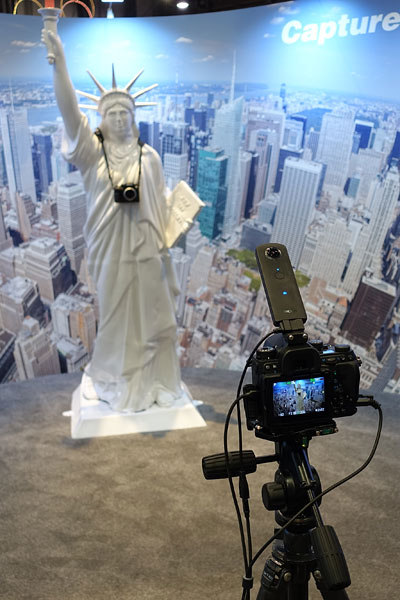
Multi-Imaging Experience
Perhaps the coolest demonstration for our money was that which the company termed the Multi-Imaging Experience. In this tech demo, the flagship K-1 DSLR was paired with a Ricoh Theta S, together providing a unique way to capture and display 360-degree spherical panoramas.
To achieve this, the Theta S was precisely aligned over the central axis of the K-1's attached lens by mounting it on the latter's hotshoe mount with a specially-designed bracket. Both cameras were then triggered to take photos simultaneously, with the Theta S providing a 360-degree spherical panorama, and the Pentax K-1 providing a much higher-resolution image for a given area of particular interest. (The size of that area depending upon which lens was in use on the K-1 body.)
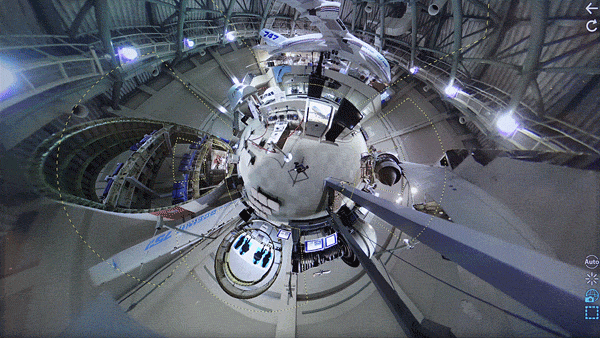
The results were then combined in software, and could be supplemented by turning the K-1 in another direction to capture additional high-res images to be added to the 360-degree panorama. And it was even possible to have the K-1 to capture multiple images of the same area within the overall scene using different focal lengths, allowing viewers to zoom in and see increasingly more detail for the most important and significant area of the scene.
Playback was handled very intuitively on a touch-screen display, with the areas of additional detail highlighted by a dashed outline overlaid on the Theta S panorama image. Much the same pinch and drag gestures you'd use to view images on your smartphone were used to browse around the 360-degree scene, just with two hands used for pinch zoom rather than two fingertips.
What was really impressive, though, was just how much additional detail could be added to the Theta S' imagery with comparitively very little effort at all. Doubtless there was plenty of work going on behind the scenes to detect the matching area of the Theta S shot to that from the K-1, warp the K-1's imagery to fit the Theta's rendering of the scene and then overlay the images correctly, but from the user's perspective nothing more than a few mouse clicks were required.
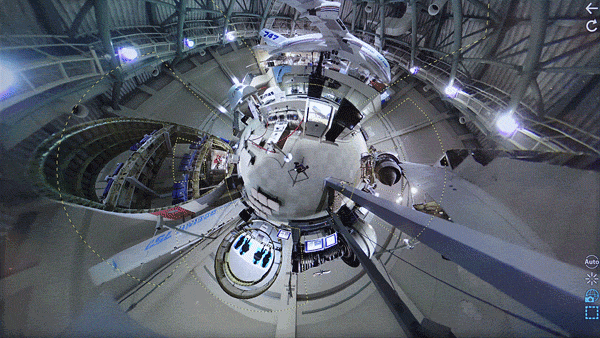
Connected Camera Experience
The Multi-Imaging Experience worked hand-in-hand with another tech demo which Ricoh referred to as the Connected Camera Experience. In a nutshell, this allows for remote image capture from across a network or the internet. In this particular demo, it's the Pentax K-1 and Theta S which are being controlled remotely, but the technology could doubtless be repurposed to work with other models.
Ricoh tells us that it sees applications for this tech in fields as diverse as industrial or agricultural (monitoring operations on farms or in factories, for example) all the way through to entertainment.
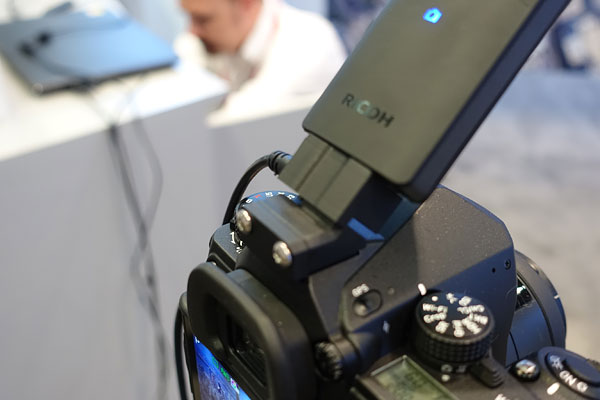
360 Live Meeting
Another internet-connected technology demonstration used the Ricoh Theta S camera to provide a visual element to the traditional office conference call. The system allowed numerous users, each with a Theta S, to connect to the call and share their own 360-degree live stream, as well as seeing those from other users.
Based on Ricoh's existing UCS video conferencing platform which already has more than 10,000 users, the 360 Live Meeting tech demo was the one which struck us as most broadly and immediately useful, although you do have to pan around the image to see who's talking. (After all, if you wore a VR headset to enable you to just look around, nobody else would be able to see *your* face.)
There are doubtless solutions which could further refine the experience, though. Imagine, for example, using face detection and directional audio to identify the current speaker, with the view automatically turning to focus on them as the conversation flows.
Ricoh's 360 Live Meeting tech really struck us as a pretty cool evolution of the standard teleconference, and one we could see being adopted by companies with a regular need for face-to-face interaction, but a staff that are scattered across multiple locations.
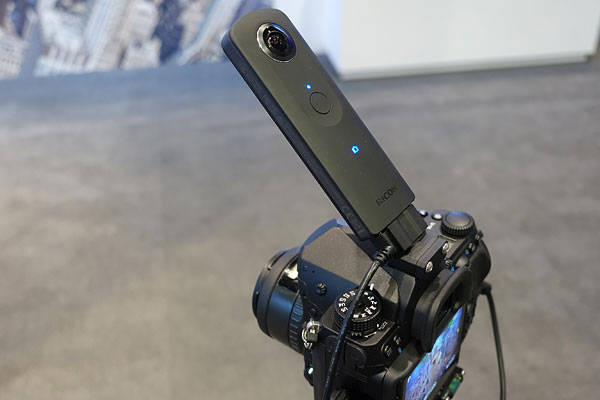
4K Video, HDR, and 3D Audio Spherical Imaging Experience
Finally for its main booth, Ricoh offered up several related demonstrations hinting at where the Theta line could go in the future. One obvious next step for the line would be to increase resolution, and that's just what was shown in a simulated demo from a 4K-capable 360-degree camera. Another possibility would be to incorporate high dynamic range capture, as since they must necessarily cover every single direction in a single image, 360-degree cameras can struggle with dynamic range. Again, Ricoh showed a demo of just this on its booth.
The last such demo probably requires just a little more information to make sense, but in essence it was a multi-directional 3D audio setup. If you stop to think about it for a moment, the problem of how to treat audio for spherical panoramas becomes obvious. You can't just slap on a stereo mic, as you could with most cameras, and be done. After all, the direction from which the viewer should perceive a sound as coming will vary depending upon which direction they're looking.
If you have, say, a band playing loud music in front of you and then you look left away from the band, you'd expect that the music would be louder in your right ear than your left. Look the other direction, and the reverse will be true. And that's just what happened in Ricoh's multi-directional 3D audio demo, with the sound altered to match the viewer's perspective as they peruse a 360-degree spherical video clip.
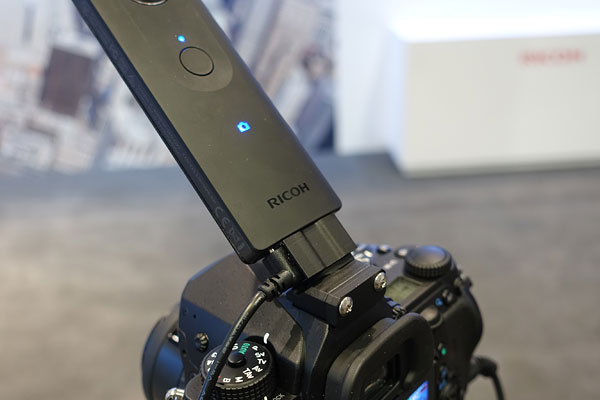
Ricoh R Development Kit
As if all of the above wasn't already plenty, Ricoh also had a second, smaller booth in a different hall on which it was featuring its brand-new Ricoh R Development Kit, which reimagines the company's Theta 360-degree imaging hardware as a 24-hour live-streaming solution. An offshoot of its Theta spherical imaging cameras, the Ricoh R is nevertheless a substantially different product which is aimed solely at live streaming, not on capture of stills and video clips.
During the show, Senior Reviews Editor Mike Tomkins was fortunate to have the opportunity to meet with Hidenao "Shu" Ubukata, Leader of the n-Project Team at Ricoh's SV Business Development Center, New Business Development Group. Ubukata-san is the creator not only of the Ricoh R Development Kit, but also of the original Ricoh Theta. Also present and ably assisting with translation was Kiyoshi Hashimoto, General Manager of the PR Department in Ricoh's Corporate Communication Center, Corporate Division.
Externally, the Ricoh R Development Kit has a basic layout that's quite similar to that of the Theta S, and it also shares that camera's lenses and image sensors. Instead of its sibling's plastic body, though, the Ricoh R Dev Kit camera has a ribbed metal body. Ubukata-san confirmed for us that this was intended to help with cooling, which is one of the key design changes responsible for allowing this camera's spectacular 24-hour streaming capability.
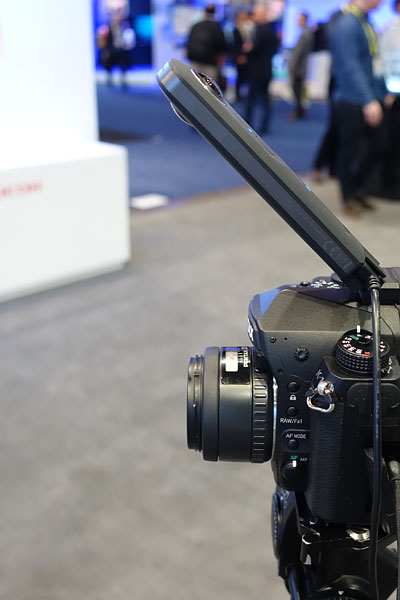
Of course, the newly-designed metal body isn't the only area in which the Ricoh R differs from the Theta S. For one thing, the Ricoh R is now capable of outputting a stitched 360-degree live stream without any additional hardware, where past Theta models could only stream unstitched, side-by-side output from the cameras' twin fisheye lenses. Achieving this stitching in real time and in-camera required the addition of a brand-new ASIC chip, according to Ubukata-san.
And there's another important difference, too. The Ricoh R lacks a built-in battery, and is instead intended to be powered via USB at all times. Given that the Ricoh R is intended to be used for live-streaming video over long periods, there was no reason to include a battery. This camera is intended only for streaming and can't be used as a standalone device anyway. In fact, it lacks any ability to shoot still images at all. Hence, powering the device externally makes a whole lot of sense.
Ubukata-san was also happy to confirm for us that Ricoh will be providing not only Windows and Mac OS apps with which to use the R Development Kit, but also will be providing an SDK allowing for remote control to be integrated into your own applications. Given that one of Ricoh's goals is for companies to incorporate the R Development Kit into their own creations, we'd imagine that there will be a fair bit of demand for this!
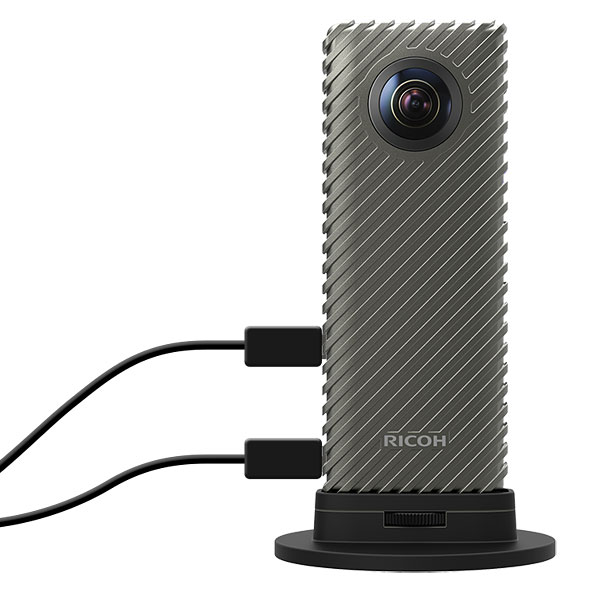
Interestingly, when I asked why the Theta name hadn't been applied to this device even though it clearly shared quite a bit of the same hardware, we were told that Ricoh hasn't yet decided whether or not to use the Theta name with this device. We got the feeling from Ubukata-san's replies that the Ricoh R Development Kit will likely continue to forego Theta branding, though.
That's partly to provide a distinction between the company's other still/video-capable 360-degree cameras, and this streaming-only 360-degree device. It also serves to indicate that the Ricoh R is intended for business use, with the Theta aimed more at consumer use. And thanks to the Ricoh R Development Kit's single-function design which does away with anything but the streaming, I got the sense that it really couldn't be much easier to use: Just plug in the cables, fire up the software and you're good to go.
In fact, Ricoh was actually live-streaming from its booth to YouTube throughout our interview session. And in a rather nice touch, although some of the flood of predominantly Japanese-language questions coming in during the session were being answered in text, Ricoh's staff told us that they'd also been answering many of the questions verbally by simply speaking in front of the camera.
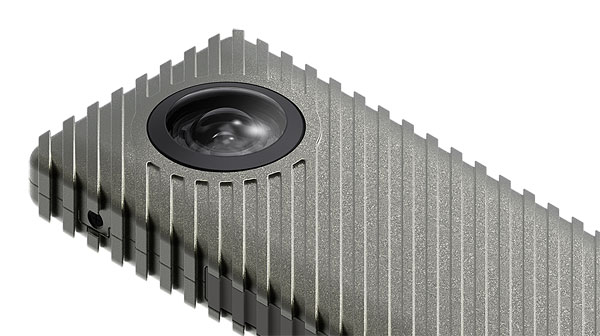
Available sometime this spring, the Ricoh R Development Kit has not yet been priced in the US market. We will of course have more for you on this interesting kit once it's final announcement is made!